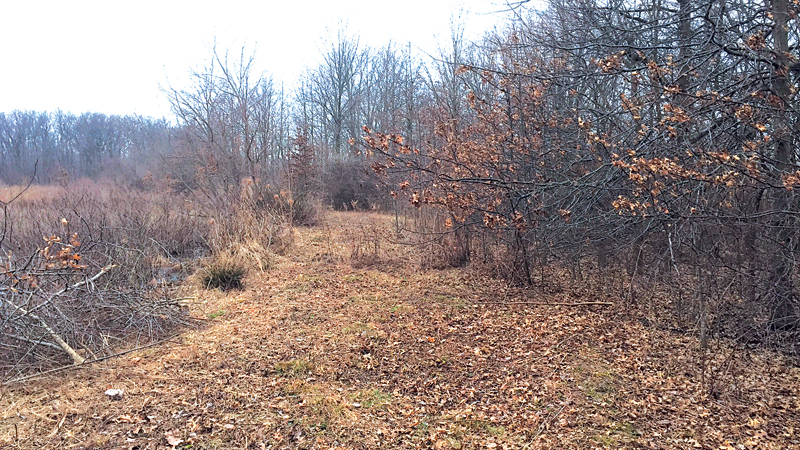RARE SCHOOL WOODLAND PROPERTY GAINS NEW SUPPORT

In 1997, the Northern Wells Community Schools (NWCS) board purchased 25 acres of wooded area adjacent to the high school. The board’s plan was to create an environmental lab. Additional trees were planted, some areas were burned, a few benches were installed and a trail was created. However, within a few years, the school changed its block schedule, and class time went from 1.5 hours to 45 minutes. Outdoor study time was no longer feasible. Other than the cross-country team, the wooded area fell into disuse within a few short years.
Gene Donaghy runs those trails, too, but recreationally. Lately, he’s taken notice of what surrounds him and sees opportunity. “We’ve got a real gem out there, it just needs some help,” he says. Donaghy is a graduate of Norwell High School and serves on the school board. “I wanted to know if the woods were worth reclaiming as an environmental center,” Donaghy says. “And I knew just who to call.”
Betsy Yankowiak is director of preserves and programs for Little River Wetlands Project in Fort Wayne, and co-stewardship director for the Northeast Chapter of the Indiana Native Plant and Wildflower Society (INPAWS). She joined Donaghy and Scott Mills, NWCS superintendent, to evaluate the site in summer 2016. Of the 25 wooded acres, Yankowiak identified four acres as a wetland, and pointed out plants species that aren’t seen often. “Quite honestly, I didn’t even know what we had,” Donaghy says. “But when Betsy got excited, I knew we had something good.”
Donaghy’s next call went to Jody Heaston. Heaston is the Indiana State Parks volunteer coordinator and works out of Ouabache State Park, less than 30 minutes from Norwell High School. For a school to own a 25-acre woods and wetland is rare, but Heaston knows that’s not enough to ensure success. “To create a true environmental study lab, we’d need interpretive signs for the habitat, trees and wildflowers,“ Heaston says. She envisions programs that involve math, biology, science, art, language, plus an environmental club. “It’s crucial that we solicit input from the teachers and staff, and enlist professional help from the state to develop a curriculum.”
Heaston also coordinates the state’s Indiana Master Naturalist Program (IMN). “Our IMNers are always looking for stewardship opportunities,” she says. Volunteer projects will include plant identification, tagging invasive plant species for later cutting and treating, widening trails and plantings. She notes that Yankowiak’s involvement opens another volunteer pool. “Having the Northeast Chapter of INPAWS helping to push this project forward is a big win.”
Donaghy loves Heaston’s other ideas, such as setting aside space for a pollinator garden, and using the school’s greenhouse as a factory for growing starter plants of native species. But he wants to think even bigger than that. As a member of the Northeast Indiana Regional Development Authority, he’s inspired by the projects that increase quality of life for area residents.
“Eventually, I’d like to hook the Norwell acreage to the Poka-bache Connector Trail,” Donaghy says. The Poka-bache, once completed, will connect Pokagon and Ouabache state parks, and will be the longest trail in Indiana. “With the kind of exposure the trail will bring, we can be the model for how community government, educators, volunteers and environmentalists can come together to create something wonderful.”
Recently, NWCS was awarded a $500 grant from INPAWS as seed money. With input from Yankowiak and Heaston, Donaghy has developed a kind of planning wish-list, and is gaining help from a scout troop, the local USDA office, Future Farmers of America (FFA), and the Wells County Extension Office. “FFA members have been hand-cutting brush and we’ve scheduled a burn to discourage some non-native plant growth. The project benefits the Bluffton Fire Department, too. It’s using the burn as a training exercise.”
Summer brings fresh excitement for all involved in the project. Heaston knows that the woods and wetland will reveal a few surprises. “Now that we’re watching, I know we’ll make new discoveries. Do we have sensitive or rare plants? The next two seasons will be exciting,” she says. Donaghy promises to keep the trails open for cross-county teams’ use. “Cross-country coaches from other schools tell me it smells different running through our woods with all the flora and the fauna. It’s such a great place. With community involvement, we can make it even better.”
- RARE SCHOOL WOODLAND PROPERTY GAINS NEW SUPPORT - April 14, 2017
- AN URBAN PRAIRIE IN WAYNEDALE - January 20, 2017
- RARE INDIANA HABITAT RESTORED, ONE SEED AT A TIME - November 4, 2016


